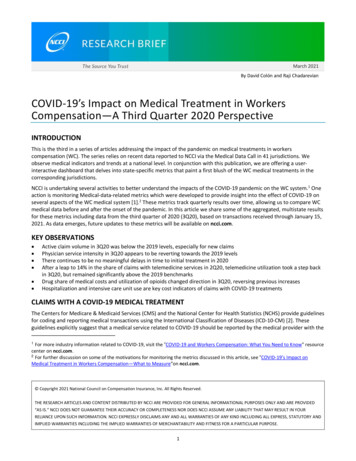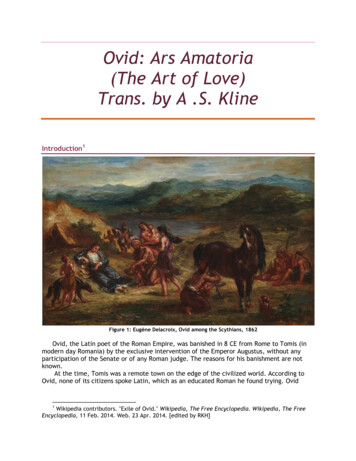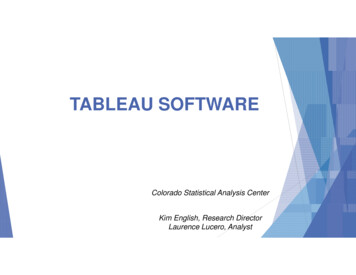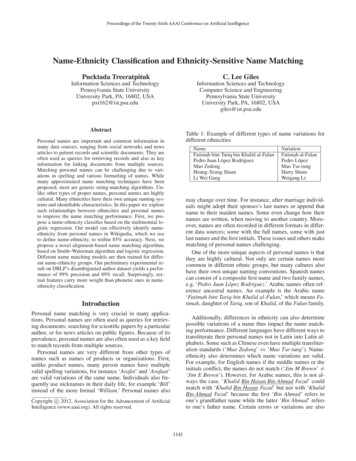
Transcription
March 2021By David Colón and Raji ChadarevianBy Authors Names HereCOVID-19’s Impact on Medical Treatment in WorkersCompensation—A Third Quarter 2020 PerspectiveINTRODUCTIONThis is the third in a series of articles addressing the impact of the pandemic on medical treatments in workerscompensation (WC). The series relies on recent data reported to NCCI via the Medical Data Call in 41 jurisdictions. Weobserve medical indicators and trends at a national level. In conjunction with this publication, we are offering a userinteractive dashboard that delves into state-specific metrics that paint a first blush of the WC medical treatments in thecorresponding jurisdictions.NCCI is undertaking several activities to better understand the impacts of the COVID-19 pandemic on the WC system.1 Oneaction is monitoring Medical-data-related metrics which were developed to provide insight into the effect of COVID-19 onseveral aspects of the WC medical system [1].2 These metrics track quarterly results over time, allowing us to compare WCmedical data before and after the onset of the pandemic. In this article we share some of the aggregated, multistate resultsfor these metrics including data from the third quarter of 2020 (3Q20), based on transactions received through January 15,2021. As data emerges, future updates to these metrics will be available on ncci.com.KEY OBSERVATIONS Active claim volume in 3Q20 was below the 2019 levels, especially for new claimsPhysician service intensity in 3Q20 appears to be reverting towards the 2019 levelsThere continues to be no meaningful delays in time to initial treatment in 2020After a leap to 14% in the share of claims with telemedicine services in 2Q20, telemedicine utilization took a step backin 3Q20, but remained significantly above the 2019 benchmarksDrug share of medical costs and utilization of opioids changed direction in 3Q20, reversing previous increasesHospitalization and intensive care unit use are key cost indicators of claims with COVID-19 treatmentsCLAIMS WITH A COVID-19 MEDICAL TREATMENTThe Centers for Medicare & Medicaid Services (CMS) and the National Center for Health Statistics (NCHS) provide guidelinesfor coding and reporting medical transactions using the International Classification of Diseases (ICD-10-CM) [2]. Theseguidelines explicitly suggest that a medical service related to COVID-19 should be reported by the medical provider with theFor more industry information related to COVID-19, visit the “COVID-19 and Workers Compensation: What You Need to Know” resourcecenter on ncci.com.2 For further discussion on some of the motivations for monitoring the metrics discussed in this article, see “COVID-19’s Impact onMedical Treatment in Workers Compensation—What to Measure”on ncci.com.1 Copyright 2021 National Council on Compensation Insurance, Inc. All Rights Reserved.THE RESEARCH ARTICLES AND CONTENT DISTRIBUTED BY NCCI ARE PROVIDED FOR GENERAL INFORMATIONAL PURPOSES ONLY AND ARE PROVIDED“AS IS.” NCCI DOES NOT GUARANTEE THEIR ACCURACY OR COMPLETENESS NOR DOES NCCI ASSUME ANY LIABILITY THAT MAY RESULT IN YOURRELIANCE UPON SUCH INFORMATION. NCCI EXPRESSLY DISCLAIMS ANY AND ALL WARRANTIES OF ANY KIND INCLUDING ALL EXPRESS, STATUTORY ANDIMPLIED WARRANTIES INCLUDING THE IMPLIED WARRANTIES OF MERCHANTABILITY AND FITNESS FOR A PARTICULAR PURPOSE.1
appropriate identifying diagnosis code in order to be reimbursed. We identify claims with a paid COVID-19 medicaltreatment other than a lab test using the diagnosis reporting and designate such claims as COVID-19 treated claims. As of3Q20,3 approximately 3,100 COVID-19 treated claims have been reported through the Medical Data Call. This does notconstitute all COVID-19 WC claims as it does not include claims that have indemnity payments but no paid medical servicesbeyond lab testing. It is also important to note that the data reported through the Medical Data Call generally does notinclude self-insured entities which commonly include hospitals, skilled nursing homes, governmental agencies, and firstresponders.Metric 1 measures the number of COVID-19 treated claims per 100K active claims as of 3Q20. A claim is considered active ifthe injured worker has at least one medical encounter during the period. Across all jurisdictions included in this study,4 thenumber of COVID-19 treated claims per 100K active claims is around 365. This COVID-19 medical treatment rate varies byjurisdiction, from less than 100 to over 300 per 100K active claims.Metric 1—Number of COVID-19 Treated Claims per 100K Active ClaimsOne measure of the severity of symptoms of the COVID-19 diagnosis is whether the patient was hospitalized. Of thosehospitalized, another measure of the severity is whether the patient is admitted to an intensive care unit (ICU). Metric 2shows statistics related to hospital admissions for COVID-19 treated claims through 3Q20. We observe the following: 19% of COVID-19 treated claims had an inpatient stayRoughly 1 out 5 inpatient stays required the patient to be in an ICU for some portion of their stayThe average length of inpatient stays for COVID-19 treated claims is 8 daysThe average cost per day is 6,400, totaling on average 54,000 per inpatient stayCOVID-19 treated claims requiring an ICU visit tend to incur longer and more expensive inpatient stays, at 11 days and 90,000 per inpatient stay, respectively3Based on transactions received through January 15, 2021.AK, AL, AR, AZ, CO, CT, DC, FL, GA, HI, IA, ID, IL, IN, KS, KY, LA, MD, ME, MI, MN, MO, MS, MT, NC, NE, NH, NJ, NM, NV, OK, OR, RI,SC, SD, TN, UT, VA, VT, WI, and WV.42
Metric 2—Hospital Admissions for COVID-19 Treated Claims19% 54KShare of COVID-19 treated claims with aninpatient stayAverage paid per stay22%67%Share of inpatient stays with ICU servicesIncrease in cost for a stay with an ICU visit8 days34%Average length of an inpatient stayIncrease in length of a stay with an ICU visitTwo interesting characteristics of COVID-19 treated claims are gender and age at injury. Metric 3 explores the genderdifference between COVID-19 treated claims and all WC claims. At 64%, females represent a larger share of the COVID-19treated claims than in the general WC claimant population. One potential contributing factor to this disparity is that womenrepresent a significantly greater portion of healthcare employment. According to the US Census, by far, the largesthealthcare occupation is registered nurses, with over 2.4 million workers, followed by 1.2 million nursing, psychiatric, andhome health aides. Women make up more than 85% of workers in both large occupation groups [3].Metric 3 also shows the age distribution for workers with a COVID-19 treatment with an average of 47 years, as comparedto the average age of the general WC claimant population of 41 years.Metric 3—Demographic Characteristics of COVID-19 Treated ClaimsCOVID-19 patients with certain comorbidities or preexisting conditions tend to be more likely to endure more severesymptoms. According to the Centers for Disease Control and Prevention (CDC), adults of any age with certain underlyingmedical conditions are at increased risk for severe illness from the virus that causes COVID-19 [4].3
Metric 4 shows the portion of COVID-19 treated claims also having some treatment for an identifiable comorbidity5 to be20%. The top three types of comorbidities observed are hypertension, chronic pulmonary disorders, and diabetes.Metric 4—Comorbidity of COVID-19 Treated ClaimsAs we reflect on these metrics in comparison to the observations made in “COVID-19’s Impact on Medical Treatment inWorkers Compensation—A First Look at 2020,” [5] we find two observations: The cost of hospitalization for COVID-19 treated claims reflects some pricier episodes and continues to evolveComorbid conditions treated under WC are more prevalent in COVID-19 treated claimsOVERALL MEDICAL CLAIM REPORTING AND PAYMENT ACTIVITYData used to analyze each of the metrics include 41 US jurisdictions. Metrics were organized on a quarterly basis to allow usto compare results before and after6 the spread of COVID-19 with the data valued at comparable time slices. The servicesprovided in the third quarter are evaluated as of January 15 of the following year. Thus, for example, the data for servicesprovided during the third quarter of 2020 is valued at January 15, 2021.Metric 5 shows the number of active claims. Two categories of active claims are: Existing claim—an active claim with a date of injury prior to the beginning of the quarterNew claim—an active claim with a date of injury during the quarterHere we see an increase of 10% in active claims from 2Q20 to 3Q20. However, the number of active claims in 3Q20 remains14% below the number of active claims in 3Q19—reflecting yet another quarter with fewer active claims. The 2020 declinein claim activity may be attributed to several possible reasons, including: A drop in risk exposure (payroll or premium)A decline in reported claimsLate reporting of claimsA decrease in medical treatments, leading to previously active claims no longer active in the current periodThe size of the change is of interest and insightful. Metric 5 reveals that in 3Q20, the number of new claims decreased by22% while existing claims decreased by 8% when compared to 3Q19, despite partly revived economic activity.Comorbidities based on NCCI’s research titled “Comorbidities in Workers Compensation.” A comorbidity is only identifiable if treated andreported during the medical encounter.6We refer to the pre- and post-COVID-19 pandemic periods in accordance with the declaration by the World Health Organization on March11, 2020.54
Metric 5—Number of Active Claims per QuarterINDIRECT IMPACT OF COVID-19 ON MEDICAL TREATMENT FOR ALL WC CLAIMSAs we collect more data on the treatment of injured workers, we find a WC system that is responding to the COVID-19pandemic. The series of metrics that follow explore the features of the system that may be starting to revert to prepandemic levels.The WC system relies on prompt access to care for injured workers. During the public health emergency, several outlets formedical services either closed or limited their services to telemedicine and, in the case of hospitals, had to defernonessential surgeries. Summer months seemed to provide a reprieve from the severe conditions of the prior quarter. Letus explore what access to care for injured workers the system afforded during that time.EMERGENCY SERVICESMost emergency care encounters in WC take place in an emergency room (ER) setting. Metric 6 explores the share of newclaims having an emergency care encounter as the first medical encounter. It shows the average share of new claims havingemergency care as the first medical encounter to be around 27% throughout the quarters of services included. In 3Q20, thisshare is slightly lower at 25%, reflecting perhaps some continued hesitation to go to a hospital, or a decrease in claimsrequiring urgent care. The 3Q20 average reflects a minor increase from 2Q20, though overall, the 2020 average remains acouple of percentage points below the average from prior years.5
Metric 6—Share of New Claims With an Emergency Service as the First EncounterTo assess if there has been a shift in the severity of injuries or illnesses associated with ER visits, we observe the categoricaldistribution of ER visits in Metric 7. For ER visits, there are five levels of severity based on current procedure terminology(CPT) codes, ranging from limited or minor problems reported with CPT code 99281 to life-threatening situations reportedwith CPT code 99285. This metric shows that 2020 medical services through 3Q20 did not exhibit a substantial shift in thedistribution of medical severity of ER visits from the prior years.Metric 7—Share of New Claims With Procedure Codes 99281–992856
Measuring the number of days between the date of injury and that of the initial treatment is an important metric that canbe used to assess delays in receiving care. Metric 8 examines the average time, in days, between date of injury (Day 0) andfirst ER encounter. It shows the 2Q20 average to be 0.2 days longer when compared to 2Q18 and 2Q19. Third Quarter 2020shows less of a difference from historical years. Is the delay an indication of limited access or hesitation to go to a hospitaland seeking alternative venues for that treatment?Metric 8—Average Time (in Days) to First ER VisitTELEMEDICINEThe CDC reports that insurance payers and professional associations for healthcare personnel have supported the transitionto telemedicine services during the pandemic [6]. Telemedicine provides access to care while reducing physical interactionbetween patients and healthcare staff—a critical feature during a pandemic. Consequently, several states acted by issuingguidance, emergency orders, and reforms to encourage and facilitate the use of telemedicine [7]. There continues to besignificant legislative and rulemaking across states to address the process and reimbursement of services when deliveredvia telemedicine.Metric 9, which measures the share of active claims with at least one telemedicine service, reflects early results. This metricillustrates significant expansion in the use of telemedicine services in WC, having increased from less than a third of apercent before 2020 to approximately 14% in 2Q20. However, with the reopening of clinics in the summer of 2020, thereseems to be a return to in-person encounters for many, bringing down the share of active claims with at least onetelemedicine service to 5%. This is still considerably above the 2019 levels and leaves the prospect of increasedtelemedicine utilization an important metric to monitor.Metric 9—Share of Active Claims With at Least One Telemedicine Service7
Metric 10 shows significant variation in telemedicine utilization across states, with the 3Q20 values ranging from about 2%in Arkansas to more than 16% in Hawaii.Metric 10—Share of Active Claims With at Least One Telemedicine Service in 3Q20Metric 11 explores the distribution of telemedicine services across physician categories. In 3Q20, the majority oftelemedicine experience was for evaluation and management services, which typically constitute about 20% of physicianservice costs. Since 2019, there had been a significant expansion in the use of telemedicine for three types of physicianservices in 2Q20: evaluation and management at 11%, general medicine at 10%, and physical medicine7 at 2%. ThirdQuarter 2020 shows a return to fewer telemedicine encounters, but still more than observed in prior years. Will theutilization of telemedicine persist?METRIC 11—TELEMEDICINE SERVICES BY PHYSICIAN SERVICE CATEGORY7Physical medicine includes medical rehabilitation services such as physical therapy.8
One type of medical service that had a substantial increase in the use of telemedicine is psychological services. Althoughthe share of claims having at least one psychological or behavioral service remains consistent with historical experience, theshare of those services provided via telemedicine increased substantially from less than half a percent prior to 2020 to 34%in 3Q20.PHYSICIAN SERVICESPhysician and medical professional services represent approximately 40% of all WC medical costs across the jurisdictionsstudied. Therefore, these services may serve as an important metric, because changes in their utilization could point towardpotential impacts on overall medical outcomes. In particular, a lower utilization could be an indicator of delays in medicaltreatment and, thus, potential delays in an injured worker’s recovery.When analyzing changes in the number of services per active claims, it is important to consider the types and intensity ofservices provided. As a tool to measure differences in Physician Service Intensity (PSI), NCCI constructed a WorkersCompensation Relative Price Index (WCRPI) [8]. The PSI is resource-based, applies by CPT codes and place of service, anddoes not vary by state or date of service. These PSIs, much like relative value units used by CMS for physician services,assign values that correspond to the amount of resources necessary to provide the service, with greater valuescorresponding to higher amounts of resources.Metric 12 shows a modest drop in the average PSI per active claim in 2Q20 when compared to the average in priorquarters, followed by an increase of 2% in the 3Q20.Metric 12—Average PSI per Active ClaimPhysical medicine and evaluation and management represent more than half of all physician payments. Metric 13 drillsdown into these physician services, examining two distinct measures of utilization: The share of claims with in-person serviceThe average PSI per active claim for the corresponding service categoryFor evaluation and management services, 2Q20 showed a decrease in both utilization measures and 3Q20 showed anincrease, partially offsetting the decrease previously observed. For physical medicine, the share of claims with such servicescontinued its steady path, while the average PSI exhibited a minor slowdown in 3Q20. This may be an indication of slightlyfewer services per active claim, while the share of claims receiving such services remained constant. Future experience canshed some light on these changes.9
Metric 13—Utilization by Type of Physician ServiceIf fewer services were provided, the question remains: Is there some additional indication of a delay in medical treatments?Metric 14 explores the number of days from the date of injury to the time of initial treatment. The metric shows nomaterial difference in the average time to the first medical encounter after injury in 3Q20 when compared to prior quartersfor evaluation and management or physical medicine.Metric 14—Average Number of Days to Initial TreatmentSURGERIESOn March 18, 2020, CMS released guidance to limit nonessential adult elective surgeries and medical and surgicalprocedures, including all dental procedures. Additionally, some states instituted mandates to limit surgeries, thusgenerating an expectation that some WC surgeries would be delayed. Medical studies have shown that delaying electivesurgery is associated with a significant increase in infectious complications and mortality. The delay is also associated with asignificant increase in hospital costs [9]. These and subsequent changes in such guidance and rules could have causeddelays in surgery and potentially impacted an injured worker’s path to recovery.10
One measure of surgical activity is the share of active claims with a surgery. Metric 15 shows that the share of active claimswith surgery remained relatively steady in the 12% to 13% range over the last 10 quarters. Furthermore, both minor andmajor surgeries8 exhibit a similarly steady pattern over this period.Metric 15—Share of Active Claims With SurgeryMetric 16, which measures the average PSI per active claim for surgery, reflects some level of fluctuation over the quarters,partly due to variation in the types of surgeries performed.Metric 16—Average PSI per Active Claim for SurgeryA service is classified as “surgical” if it falls within the surgical category as defined by the American Medical Association. A service is furtherclassified as “major surgery” if it has a global follow-up period of 90 days as defined by the Centers for Medicare & Medicaid Services and isnot an injection.811
Metric 17 measures the average number of days elapsed from the date of injury to the date of initial major surgery. Earlierobservations of 1Q20 and 2Q20 identified no significant difference in the time to first treatment in 2020 as compared tohistorical experience. This metric indicates that, on average, WC injured workers did not experience significant delays inmajor surgeries during 3Q20 based on claims that had a major surgery.Metric 17—Average Number of Days to Initial TreatmentPRESCRIPTION DRUGSAs we consider the role that prescription drugs play in the treatment of WC injuries, Metric 18 measures the share ofmedical costs attributed to prescription drugs. In recent years, the share of prescription drug costs has been decreasing,with 1Q20 hitting a low of 9%. Subsequent observations in 2Q20 and 3Q20 appear to reflect slight variations in prescribingpatterns, likely responding to the closures that took place in 2Q20 and the subsequent reopening in 3Q20. Changes in thenumber of prescriptions per active claim are partially responsible for that fluctuation, but they do not fully explain it.Metric 18—Share of Medical Costs Attributed to Prescription Drugs12
Two potential questions come to mind: Could it be that delayed medical treatments have caused an increase in the prescribing patterns followed by a partialoffset, due to the return to higher treatment levels, such as office visits and surgery?Or could the increase in prescribing patterns have been caused by a fluctuation in prices paid for prescription drugs?While a definitive answer requires further data, the observed phenomenon warrants further investigation.Pain management, often a critical part of an injured worker’s recovery, has included the use of opioids in the past. In 2019,opioids represented approximately 20% of all prescription drug costs. However, that share has been on the decline forseveral years. Metric 19 examines the share of drug claims9 with at least one opioid prescription and shows that the sharehad been on the decline since 2018 at an average rate of 3% per quarter. However, that decline came to a halt in 2Q20,with more than one out of three drug claims having an opioid prescription. Metric 19 shows that the apparent trendreversal may have been a temporary bump, as the share declined in 3Q20. Will it hold steady because of changedprescribing patterns or will the decrease of prior years resume? Future data will tell us more, but it could be a while beforethe trend stabilizes again.Metric 19—Share of Drug Claims With at Least One Opioid Prescription9A claim with at least one prescription during the period.13
The CDC provides a way to convert daily—or hourly—doses of opioids to an equivalent daily dose of morphine. This is doneby assigning a conversion factor to each type of drug, thus deriving the Morphine Milligram Equivalent (MME) per opioidprescription. MME serves to assess the amount of morphine prescribed. Metric 20, the cumulative change in the averageMME per opioid claim, shows a decreasing pattern at an average rate of 3% per quarter through the end of 2019, coming toa halt in 2020. The first two quarters appear to have shaved off almost half of the decreases in 2018 and 2019. Come 3Q20,we observe a 7% decrease in the average MME per opioid claim. The fluctuations could be in response to healthcare facilityclosures in 2Q20, followed by partial reopening in 3Q20. However, the pattern could also be an indication of painmanagement alternatives slowing down while injured workers were awaiting more direct and critical treatment, which inturn resumed in part in 3Q20.Metric 20—Cumulative Change in the Average MME per Opioid ClaimCONCLUDING REMARKSThe third quarter of 2020 has unveiled some fluctuation in the medical metrics related to the treatment of injured workers,indicating a level of uncertainty in the full impact of the pandemic on the WC system. The data also indicates an evolvingstory, yet to be told in full. Looking at the first three quarters of 2020, we can identify general demographics and costcharacteristics of claims having COVID-19 medical treatments. Nevertheless, the measures of the potential indirect impactof the pandemic on medical services provided to all injured workers in the first three quarters of 2020, at first blush, do notshow evidence of substantial disruption.With this publication, NCCI is releasing a dashboard that provides a state-specific look at some of the metrics describedhere. The dashboard can be found here, in the Insights section of ncci.com.ACKNOWLEDGMENTThanks to Alana Ergui, Amelia Carroll, and Nicole Garcia for research assistance and data visualization. Also, thanks to SeanCooper and Daniel Clayman for their thoughtful review.14
REFERENCES[1] Chadarevian, Raji, “COVID-19’s Impact on Medical Treatment in Workers Compensation—What to Measure,” NCCI,October 19, 2020, ToMeasure.aspx[2] Centers for Disease Control and Prevention (CDC), “ICD-10-CM Official Coding and Reporting Guidelines, April 1, 2020through September 30, 2020,” 2020, l.pdf[3] Cheeseman Day, Jennifer, and Cheridan Christnacht, “Women Hold 76% of All Health Care Jobs, Gaining in Higher-PayingOccupations,” August 14, 2019, -care-in-womens-hands.html[4] Centers for Disease Control and Prevention (CDC), “People with Certain Medical Conditions,” precautions/people-with-medical-conditions.html[5] Colón, David and Raji Chadarevian, “COVID-19’s Impact on Medical Treatment in Workers Compensation—A First Lookat 2020,” NCCI, December 2020, www.ncci.com/Articles/Documents/Insights pdf[6] Centers for Disease Control and Prevention (CDC), "Using Telehealth to Expand Access to Essential Health Servicesduring the COVID-19 Pandemic,” 2020, tml[7] Carroll, Amelia, “Telemedicine—COVID-19 Affects Medical Service Delivery in 2020,” NCCI, December 2, cine-WorkersComp-COVID-19.aspx[8] Corro, Dan, Barry Lipton, and John Robertson, “The Use of Networks to Care for Injured Workers—What’s Been theImpact?,” NCCI, March 23, 2020, k-to-Care-for-Injured-Workers.aspx[9] Vogel, Todd R., Viktor Y. Dombrovskiy, and Stephen F. Lowry, " In-Hospital Delay of Elective Surgery for High VolumeProcedures: The Impact on Infectious Complications,” The National Center for Biotechnology Information (NCBI), 15
OVID-9's Impact on Medical Treatment in Workers ompensation—A Third Quarter î ì î ì Perspective INTRODUCTION This is the third in a series of articles addressing the impact of the pandemic on medical treatments in workers compensation (WC). The series relies on recent data reported to NCCI via the Medical Data Call in 41 jurisdictions. We


![What's in a Name? Book of Mormon Language, Names, and [Metonymic] Naming](/img/33/whats-in-a-name-book-of-mormon-language-names-and-metonymic.jpg)







